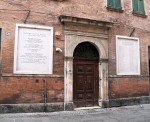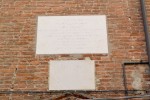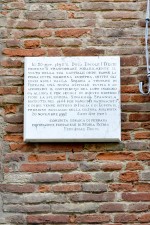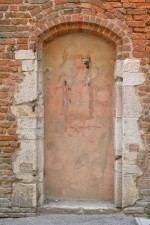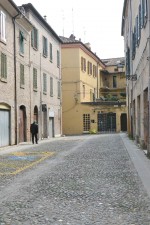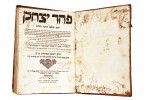Jewish Typography

Between the end of the fifteenth century and the middle of the sixteenth century Ferrara was one of the capitals of Jewish publishing in Italy.
1. 15th century and 16th century
Jewish typographic art in Ferrara expressed its splendour in two distinct periods: the first around 1477; the other around the mid-sixteenth century. The first phase was marked by the activity of Abraham ben Chaìm (or Haim): son of a rabbi, he worked as a dyer in Pesaro before moving to Ferrara, where he became a book editor and published a commentary on the book of Job and a collection of ritual orders. Described as "vir in arte sua versatissimus", in 1482 he returned to Pesaro and then settled in Bologna, where he continued his work in typography.
The second phase was related to the years 1551-1558, when the printers Samuel ben Askarà Safardì (or Samuel Gallus, of French origin) and Abraham Usque were very active in Ferrara: in a few years they published 28 volumes of theology in Hebrew and six in Spanish and Portuguese. Samuel Gallus published, among other works, an important philosophical text by the Portuguese biblical scholar and commentator Isaac Abrabanel. Abraham Usque, perhaps of Spanish family, as his surname (from the region of Huesca) indicates, but who was born and worked as a printer in Lisbon – where he was known as Duarte Pinel – gave the prints a magnificent Biblia Española, a copy of which is now kept in the Municipal Library of Ferrara.
The second flourishing phase also involved Yomtob Atias (a Portuguese merchant of Spanish origin) who in 1552, on his own initiative, translated and published in Spanish the Siddur, a book of Jewish prayers thanks to which former conversos who did not read Hebrew could recite prayers and follow ceremonies.
After the great undertaking of the Spanish Bible, in 1553 Abraham Usque took over the typography of Yomtob Atias and Jerónimo Vargas: in the following five years he published 25 liturgical works in the Hebrew language; the typographic mark of the Usque workshop is the armillary sphere (spherical astrolabe).
2. The Age of the Ghetto
At the end of the seventeenth century two Jewish printers, Joseph Nissim and Abraham Chaim, worked in the typography of the Christian Girolamo Filoni and in 1693 they printed the prayer book Siddur miberakhah seu Ordo benedictionis, with valuable engravings reproducing the signs of the celebrant in the Easter liturgy (also in the Municipal Library of Ferrara). However, due to the anti-Jewish restrictions imposed by the Holy See, Filoni was forced to dissolve the company and merge the Jewish typographies. In 1767, Ferrara's Jewish community decided that some students of the Jewish school would help the printer Salvador Serri to learn and preserve this important craft.
Bibliography
- Chiappini, Alessandra, Immagini di vita ferrarese nel secolo XVII in La chiesa di San Giovanni Battista e la cultura ferrarese del Seicento, Electa, Milano 1981 , p. 20
- Muzzarelli, Maria Giuseppina, Gli Ebrei, in Bocchi, Francesca (a cura di), Storia illustrata di Ferrara, Vol. II, AIEP, Repubblica di San Marino 1987, pp. 465-480
- Leoni, Aron, Gli Ebrei a Ferrara nel XVI secolo, in Prosperi, Adriano - Chiappini, Alessandra (a cura di), Storia di Ferrara. VI. Il Rinascimento. Situazioni e personaggi, Corbo, Ferrara 2000, pp. 278-311
Sitography
Related places
Related Themes
Related Subjects
Related Objects
Compiling entity
- Istituto di Storia Contemporanea di Ferrara
Author
- Edoardo Moretti
- Sharon Reichel

